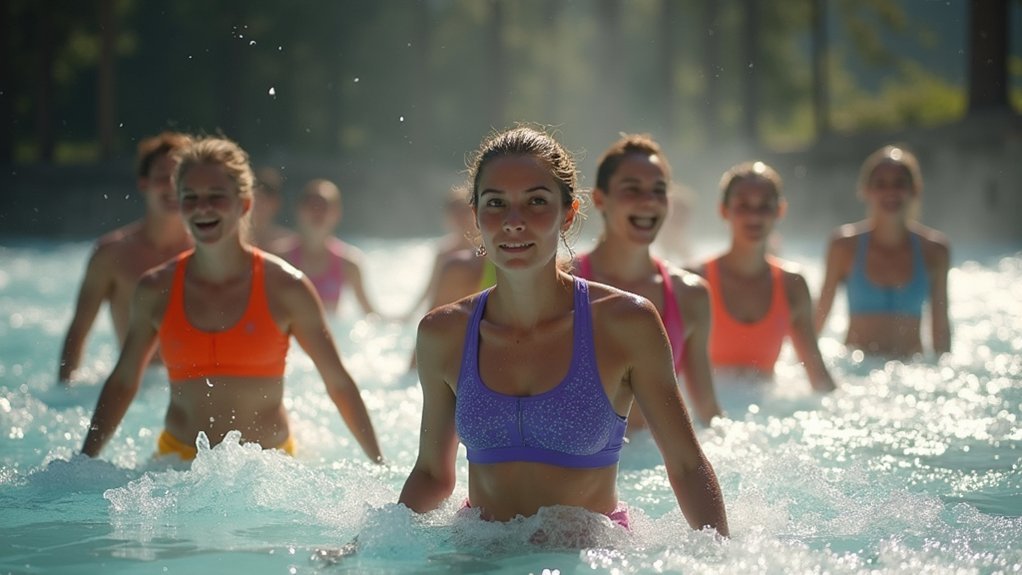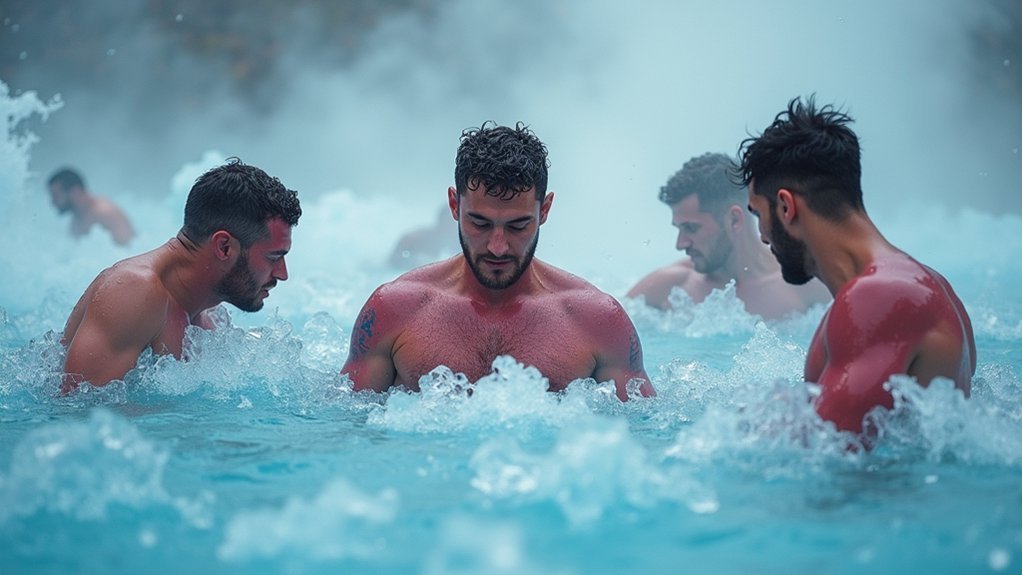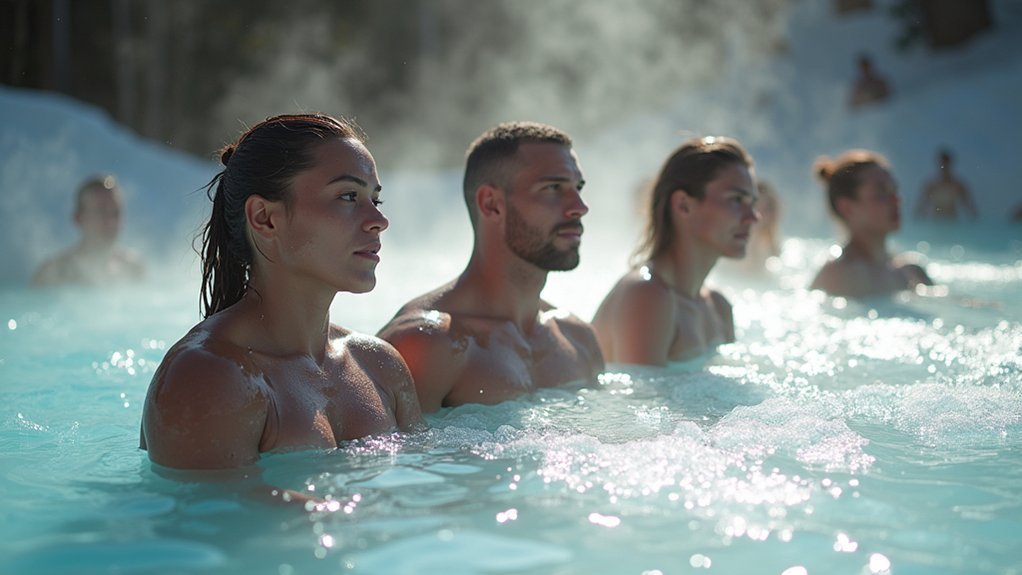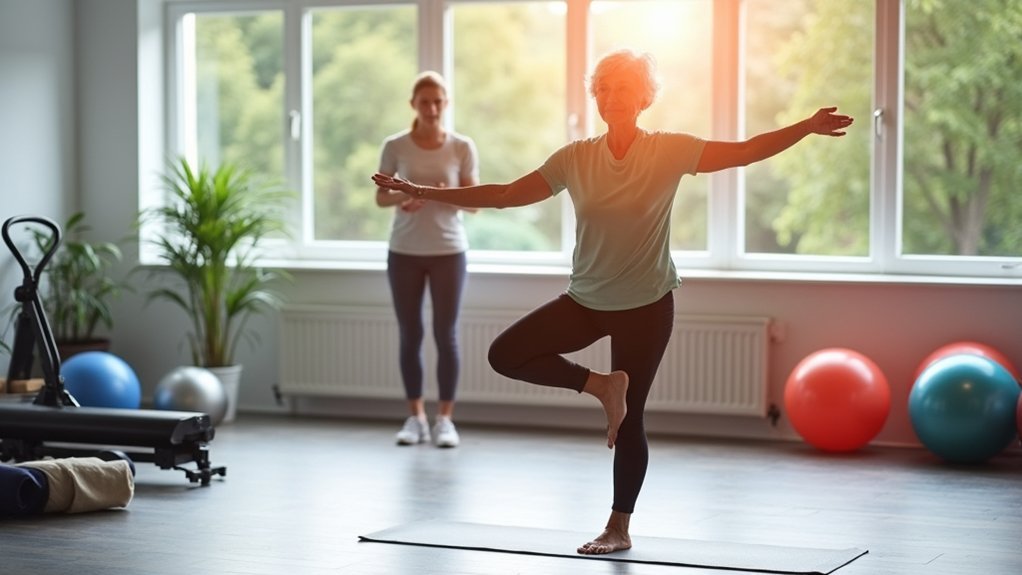Ice baths after jump workouts reduce muscle soreness and inflammation by constricting blood vessels and numbing nerve endings. They help decrease ankle joint stiffness and promote faster recovery through limited inflammatory responses. Take your cold plunge 30-60 minutes post-workout for maximum effectiveness, starting with 1-2 minutes at 12-15°C. Beyond physical recovery, cold immersion builds mental resilience and improves focus for future performances. The benefits extend far beyond just cooling down tired muscles.
The Science Behind Cold Water Immersion for Jumpers

When athletes plunge into an ice bath after intense jump training, they’re engaging with a complex physiological process that directly impacts their performance and recovery.
The cold water (typically 10-15°C) immediately alters muscle recruitment patterns, decreasing EMG activity in key jumping muscles like the gastrocnemius and rectus femoris.
Immediate cold immersion reshapes how your jumping muscles activate, measurably reducing electrical signaling in critical lower-body power generators.
This physiological response affects your biomechanics in several ways. The altered neuromuscular activity temporarily reduces ground reaction force, creating softer landings but potentially impairing rebound jump height. You’ll notice changes in the stretch-shortening cycle essential for explosive jumping movements. CWI has been shown to significantly reduce ankle joint stiffness after drop jump exercises, which may affect overall jumping efficiency.
While immediate performance might decrease, your body gains recovery benefits—reduced inflammation markers and muscle damage—that can enhance long-term training adaptations.
The cold exposure also triggers neurotransmitter release that may improve your mental resilience and stress management capabilities.
Immediate Muscle Recovery Benefits for Rebounding Athletes
Athletes immersing in ice baths after jump sessions experience immediate muscle recovery benefits that transform their rebound capabilities. Cold water immersion at 50-59°F for 10-15 minutes numbs nerve endings, reducing perceived soreness while constricting blood vessels to limit inflammatory responses.
- Reduced Muscle Soreness – Pain signals slow down through vasoconstriction, allowing you to maintain training frequency with minimal downtime.
- CNS Recovery – Your reaction time and explosive movement quality improve for subsequent workouts through neural fatigue reduction.
- Inflammation Control – Localized cooling limits inflammatory cytokines and reduces swelling in jump-stressed tissues. Scientific evidence supporting these benefits remains weak and inconclusive, though many athletes report subjective improvements.
- Damage Prevention – Your muscles stabilize microtears while accelerating metabolic waste clearance, despite temporarily reduced blood flow.
These benefits directly support your ability to maintain high-quality jump training sessions with minimal recovery time between workouts.
Reducing Post-Trampoline DOMS and Inflammation

After high-intensity trampoline sessions, your muscles endure significant eccentric stress that triggers delayed onset muscle soreness (DOMS) and inflammatory responses.
Ice baths effectively mitigate these effects through vasoconstriction, which reduces blood flow to affected areas and limits swelling.
Vasoconstriction from ice baths restricts blood flow to inflamed areas, minimizing swelling and accelerating recovery after intense exercise.
When you immerse yourself in cold water post-workout, you’ll experience a numbing effect that temporarily relieves muscle pain. As your body later warms up naturally, fresh nutrient-rich blood rushes to your recovering muscles, potentially enhancing the healing process. Maintaining water temperatures between 50-59°F maximizes these recovery benefits while ensuring safety.
Regular cold immersion can delay DOMS onset, decrease perceived exertion, and allow you to resume training sooner.
This practice not only addresses immediate discomfort but also contributes to long-term performance improvements by enabling more consistent training schedules and reducing overall recovery time between sessions.
Optimal Timing: When to Ice Bath After Aerial Workouts
The strategic timing of your ice bath can greatly influence its effectiveness following aerial workouts. For most aerial activities, aim to immerse yourself 30-60 minutes post-workout, staying in the cold water for 10-15 minutes at temperatures between 5-15°C.
Your timing should align with your specific training goals:
- Performance Recovery – Take an ice bath shortly after your aerial session if you’re focused on quick recovery for another workout later that day.
- Muscle Building – Delay cold therapy by 24-48 hours if muscle growth is your priority.
- High-Intensity Training – Schedule ice baths after each intense aerial workout.
- Moderate Training – Limit cold immersion to 2-3 times weekly for less demanding aerial practice.
Morning ice baths may be particularly effective as they synchronize with your body’s natural temperature rise after waking up.
Listen to your body and adjust timing based on how you personally respond to cold therapy.
Mental Resilience Benefits of Cold Therapy for Rebounders

Cold immersion therapy trains your mind to overcome discomfort, building mental fortitude that transfers to your jumping workouts.
You’ll develop the ability to push through physical and mental barriers as you adapt to cold stress, strengthening your anterior midcingulate cortex – the brain region responsible for willpower.
Regular ice baths can boost your psychological recovery by reducing anxiety and improving mood, giving you a mental edge in high-pressure situations. The increased release of endorphins and norepinephrine during cold water immersion enhances your resilience to stress while promoting positive emotional states.
Mind Over Discomfort
Plunging into freezing water might seem intimidating at first, but this practice builds more than just physical recovery for jump athletes—it cultivates essential mental fortitude.
Each time you willingly step into an ice bath, you’re training your mind to overcome discomfort and build resilience that transfers directly to your athletic performance. Regular cold plunges release natural endorphins that help athletes manage competitive pressure more effectively.
Cold therapy helps you develop mental toughness through:
- Stress response management – You’ll learn to control breathing and remain calm under pressure
- Enhanced focus – Regular exposure improves your ability to concentrate during high-stakes competitions
- Hormetic adaptation – Controlled cold stress rewires your brain for greater resilience
- Reduced cortisol levels – Lower stress hormones improve your composure when facing athletic challenges
This mental resilience becomes invaluable when you’re pushing through tough jump workouts or competition pressure.
Psychological Recovery Boost
Beyond physical rejuvenation, ice baths provide jump athletes with substantial mental fortitude benefits that amplify your overall recovery process. The endorphin release triggered during cold immersion elevates your mood while simultaneously reducing cortisol levels, creating a powerful stress-relief combination.
Regular ice bath sessions cultivate emotional regulation and discipline as you learn to breathe through discomfort. This practice builds transferable mental resilience that serves you during high-pressure competitions. Athletes consistently report improved focus and resilience through regular exposure to cold water therapy. The norepinephrine surge sharpens your cognitive function, potentially enhancing your decision-making abilities on the court or field.
Perhaps most valuable is the autonomic nervous system rebalancing that occurs post-immersion, shifting you toward parasympathetic dominance – essential for peak mental recovery between intense jumping sessions.
This neurochemical reset helps prevent burnout while reinforcing your self-efficacy with each completed session.
Creating Your Own Ice Bath Protocol for Jump Recovery
After understanding the science behind ice baths for jump recovery, it’s time to design your own personalized protocol.
Start with these fundamental elements to maximize your recovery benefits while respecting your body’s limits:
- Begin gradually – Start with just 1-2 minutes in water between 12-15°C, then increase duration as your tolerance improves over several sessions.
- Time it right – Immerse yourself within 15-20 minutes after completing your jump workout for ideal inflammation reduction.
- Monitor your response – Adjust duration based on workout intensity—longer baths (8-10 minutes) for more intense sessions.
- Complete the recovery cycle – After your bath, focus on gradual warming, hydration, and consuming protein and carbohydrates to support muscle repair. Consider your body composition when determining the appropriate intensity and duration of your ice bath protocol.
Complementary Recovery Techniques to Enhance Ice Bath Effects
While ice baths provide significant recovery benefits on their own, their effectiveness can be dramatically amplified when paired with complementary techniques. To maximize your recovery after jump workouts, consider integrating these methods alongside your cold immersion routine. Research shows that ice baths effectively reduce delayed onset muscle soreness experienced after high-impact jumping exercises.
| Technique | Benefit with Ice Baths |
|---|---|
| Active Recovery | Light movement improves circulation while maintaining the anti-inflammatory effects |
| Compression Garments | Enhances blood flow to complement the reduced inflammation from ice therapy |
| Proper Nutrition | Antioxidant-rich foods support cellular repair initiated by cold exposure |
| Adequate Sleep | Optimizes hormonal recovery responses triggered by ice baths |
| Foam Rolling | Targets specific muscle groups before or after ice immersion for deeper relief |
Your recovery strategy should be as deliberate as your training plan, creating a thorough approach that addresses both the physiological and neurological aspects of jump workout recovery.
Frequently Asked Questions
Can Ice Baths Negatively Impact Muscle Growth After Jump Training?
Yes, ice baths can hamper your muscle growth after jump training by blunting anabolic signaling, reducing amino acid utilization, and suppressing satellite cell activity—especially when taken immediately after your workout within the first hour.
How Do Ice Baths Compare to Contrast Therapy for Jumpers?
Ice baths offer intense cold therapy for reducing inflammation, while contrast therapy alternates temperatures to enhance blood flow. You’ll find contrast therapy more balanced for circulation, but ice baths might better reduce acute soreness after jumping exercises.
Are There People Who Should Avoid Ice Baths After Jump Workouts?
You should avoid ice baths if you have hypertension, Raynaud’s, cardiac issues, open wounds, or are elderly, pregnant, or immunocompromised. Don’t use them when recovering from surgery or with neurological conditions.
What’s the Minimum Effective Temperature for Post-Jump Ice Baths?
For effective post-jump recovery, you’ll want your ice bath at least 50°F (10°C) or lower. The ideal range is between 50-60°F (10-15°C), which provides recovery benefits while remaining tolerable for most athletes.
Do Ice Baths Affect Performance if Done Before a Jump Workout?
Yes, ice baths before jumping will hurt your performance. You’ll experience 17-37% decreases in vertical jump height, slower movement, and reduced power that can last 20-30 minutes due to decreased muscle temperature and nerve function.
In Summary
You’ve discovered a powerful recovery tool in ice baths for your jump training. They’ll reduce inflammation, accelerate muscle repair, and build mental toughness when used properly. For best results, time your cold plunges 10-20 minutes after intense sessions, keep temperatures between 50-59°F, and stay immersed for 10-15 minutes. Combine with proper nutrition, stretching, and adequate sleep to maximize your vertical gains and jumping performance.





Leave a Reply